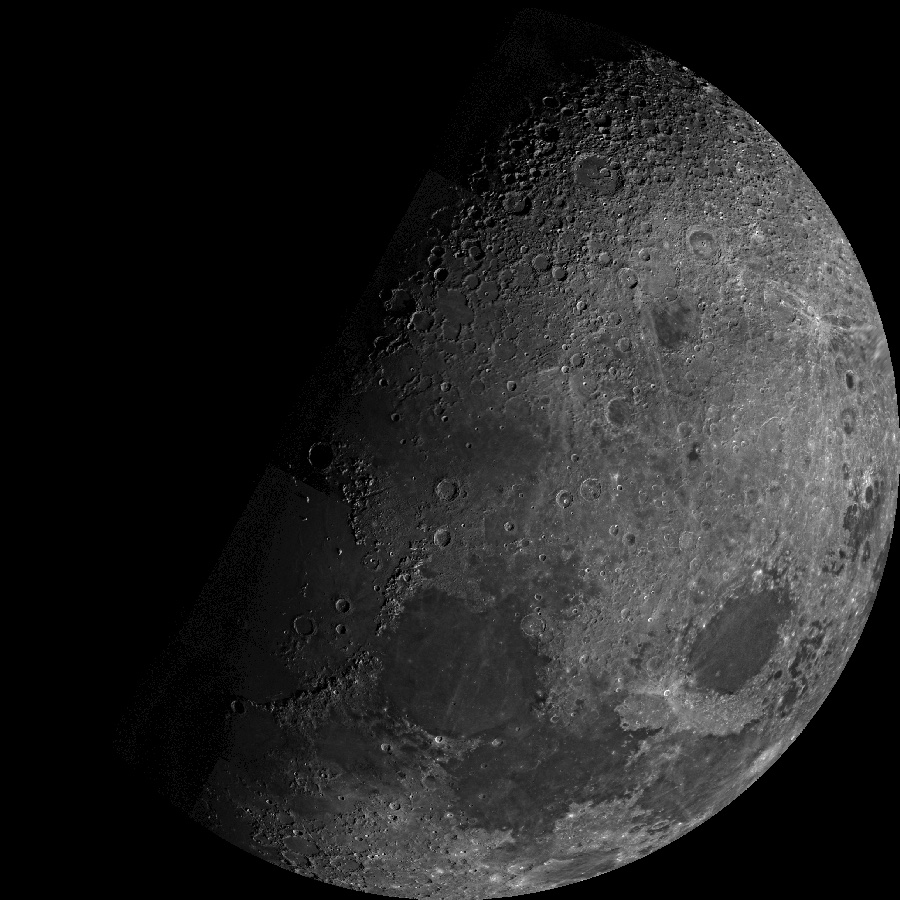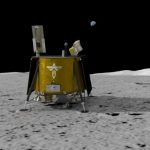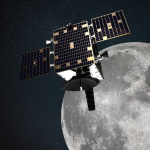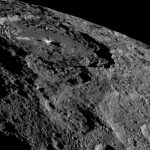A look at lunar in-situ PNT GNSS-like frequencies and how we can open the “radio window” into the universe.
JEAN-LUC ISSLER, JEAN PLA, ROMAIN DESPLATS CENTRE NATIONAL D’ETUDES SPATIALES (CNES)
Radio astronomy (RA) in the shielded zone of the Moon (SZM) is an exceptional scientific opportunity to open the “radio window” into the universe. However, for lunar in-situ PNT, the GNSS L and C bands pose important threats to RA continuum and spectral lines observations. The 2,483.5 to 2,500 MHz Radio Determination Satellite Service (RDSS) S-band is the optimal frequency band for lunar in-situ PNT, while protecting RA in the SZM.
There is a need to meticulously design forthcoming lunar in-situ PNT GNSS-like systems [1]. This article focuses on the necessary RA protection within the SZM, which includes the Far Side of the Moon. Three fundamental concerns related to lunar in-situ PNT are highlighted:
Unparalleled Opportunity for RA. Within the SZM, an arena untouched by Earth’s radio interference, multiple RA space missions are planned for the short, mid and long terms [1]. One such mission is already active in the SZM, and others will be soon [1]. SZM offers an unmatched vantage to fully observe the radio universe in terms of dynamic, spectral lines and associated molecules with a resolution significantly better than on Earth. Consequently, any lunar in-situ PNT and communication links (e.g., orbiter to surface, surface to orbiter, surface wireless) must align with the imperatives of RA.
ITU Radio Regulation and Recommendations. The International Telecommunication Union’s (ITU) Radio Regulation (RR) and diverse international recommendations [5],[6] exclude lunar in-situ GNSS-like systems in L-band, which initially was supposed to leverage low Earth orbit (LEO) and terrestrial GNSS receivers for lunar applications. The authors recommend using the 2,483.5 to 2,500 MHz S-band in regard to the Space Frequency Coordination Group (SFCG) and ITU radio regulation and recommendation on lunar frequency bands. Notably, this S-band also allows leveraging LEO and terrestrial GNSS receivers, mitigating interferences with C/N0 based Binary Offset Carrier (BOC) mainlobe(s) and related filter selection algorithms and/or with other interference mitigation techniques like dynamically selectable pulse blanking or spectral nulling. This leveraging includes S-band receiving parts of Indian Radio Navigation Satellite System (IRNSS), BeiDou-3 and Globalstar [1] constellations, and later Korean Positioning System (KPS), GNSS augmentation System (UAE’s GNSSaS), Synchrocube (France, a consortium including Syrlinks and U-Space companies, for timing applications), and FuturNav (European Space Agency), all while ensuring the absolute integrity of RA within the SZM. By choosing the GNSS S-band, the designers sidestep harmful and global interference to RA that occurs if L-band is used across the Moon surface [1]. This article also outlines why GNSS C-band should not be used for in-situ lunar PNT.
Synergizing Lunar and Terrestrial GNSS Signals. Concurrently receiving in-situ lunar GNSS-like signals in S-band and “terrestrial” GNSS signals in L-band, particularly over the Near Side of the Moon, opens doors to enhanced navigation capabilities in lunar operations.
This article underscores the significance of a thoughtful and strategic approach to lunar navigation and communication, ensuring compatibility with RA within the SZM. Given the critical importance of frequency selection, a fundamental query arises: Is there an alternative frequency band available in addition to S-band?


Exploring the Viability of the C-Band
SZM is defined by the ITU RR (Figure 1).
The question is, can Radio Navigation Satellite Service (RNSS) C-band (5,010 to 5,030 MHz) be used for lunar in-situ PNT? By simply applying ITU Radio Regulation [5] and ITU recommendations (like [6]) related to frequency bands in the SZM, C-band is not possible, in line with the interest of C-band for RA in the SZM for radio astronomers (and the related protection granted through ITU RR).
A terrestrial RA C-band (4,800 to 5,000 MHz) and its neighborhood are very important for RA on Earth and in the SZM. This band contains a spectrum line used for fundamental studies of interstellar clouds and the universe’s dynamic formation. This is the H2CO line at 4,829.7 MHz (central frequency with Doppler shift above and below). The 4,990 to 5,000 MHz extended band is used for Very Long Baseline Interferometry (VLBI) observations. These two bands, 4,800 to 4,990 MHz (secondary status on Earth) and 4,990 to 5,000 MHz (primary status on Earth), are observed by big radiotelescopes in Germany, Italy, the Netherlands, the UK and Sweden, for example. Interests of RA observations of C-bands from the SZM include their radio-pollution on Earth, the interferences in their neighborhood, and VLBI observations in 4,990 to 5,000 MHz considering Moon-Satellites-Earth baselines, for instance. RA observations in 5,000 to 5,030 MHz (an RA band in the SZM) and above are also important for RA in the SZM. For example, the ASTRON Russian Radio Astronomy satellite made RA observations below and above 5,000 MHz. ASTRON has an apogee at 390,000 km (a « lunar » distance), and a 10 meters deployable parabolic RA antenna.
It is essential for radio astronomers to keep a quiet frequency band between 3,800 MHz and 5,150 MHz in the SZM to perform continuum and spectrum line RA observations. For the moment, there is neither a lunar radiocommunication band nor a lunar radar band between 3,800 MHz and 5,150 MHz. Radio
astronomers must precisely keep wide portions of spectrum free of interference in the SZM to perform continuum and spectrum line observations.
There are about 60 resting spectrum lines between 5,000 and 5,030 MHz and more than 60 other resting lines between 5,030 and 5,060 MHz. Most of these lines are linked to carbon bio-chemistry.
Therefore, all what preceed, independently of ITU Recommendations and ITU RR, shows there is RA interest for continuum, spectrum lines and VLBI observations in 5,010 to 5,030 MHz C-band in the SZM. This is a sufficient reason to avoid C-band for in-situ lunar PNT. This also means not only should the 3,800 to 5,030 MHz band be protected for RA in the SZM, the 5,030 to 5,150 MHz band should be as well.


ITU-R Recommendations
According to ITU-R recommendation RA.479-5 (protection of RA in the SZM) for the 3-20 GHz range: “The continuum bands used by radio astronomers are in the neighborhood of the following bands allocated to the passive services: 4.99-5.0 GHz, 10.68-10.7 GHz and 15.35-15.4 GHz.” The 5,010 to 5,030 MHz is clearly within the neighborhood of 4,990 to 5,000 MHz; this is well correlated with the RA interests previously mentioned to observe red and blue shifts within the terrestrial RA C-band, targeted blue shifts as well as a number of spectrum lines notably inside the RNSS C-band. That is why ITU recommendation RA.479-5 also provides a sufficient reason to avoid 5,010 to 5,030 MHz for in-situ lunar PNT.
According to ITU-R recommendation RAS.479-5 (protection of RA in the SZM) in its Annex-2, “Resolution B16 of the 1994 XXIIth General Assembly of the International Astronomical Union (IAU) recommends that, once radio astronomy observations in the Shielded Zone of the Moon (SZM) commence, radio transmissions in the SZM be limited to the 2.0-3.0 GHz band, but that an alternate band at least 1 GHz wide be identified for future operations on a time-coordinated basis between radio astronomy and lunar communication systems.” This ITU-R Recommendation, RA.479-5, is one of the reasons the in-situ PNT 2,483.5 to 2,500 MHz has been chosen as a baseline for LUNANET and adopted as the sole lunar in-situ PNT frequency band by the SFCG [3], including in the last version of this recommendation issued in June 2023 [3]. The communication bands selected by LUNANET above 3 GHz are also compatible with SFCG [3].
Recommendation ITU-R RA.479-5 also recommends in its Annex-1 that the 0 MHz to 30 MHz and the 300 MHz to 2 GHz ranges should be reserved for RA observations in the SZM, and active services should avoid the range below 300 MHz. This explains why lunar in-situ PNT sub-constellations from NASA, JAXA and ESA are not planned in L-band [1], [3]. Moreover, a lunar in-situ PNT system in L-band would create harmful interference to reception of GNSS L-band “terrestrial” signals in the lunar envrioment, which at least these space agencies plan to use in addition to local S-band PNT signals.
LUNANET is an international framework involving an interoperable lunar communication and PNT infrastructure in which the U.S., European and Japanese space agencies are involved, with hopefully other space agencies to come. LUNANET’s international designers have chosen the 2,483.5 to 2,500 MHz S-band for lunar in-situ PNT as a baseline [2]. This S-band is the only band SFCG recommends for in-situ lunar PNT [3]. The question of possibly using a third band for in-situ lunar PNT that is neither L-band nor S-band has been raised.


Provisions of the ITU-R Radio Regulation (RR)
The discussion around protecting the 4,990 to 5,000 MHz band is a minor point compared to the RA protection granted by the Radio Regulation in the SZM. This protection was already effective even when lunar surface based or orbiting RA observatories were not yet in place. In the SZM, harmful interference to current and future RA is only permitted in the frequency bands allocated to a small set of services, as mentioned in ITU Radio Regulation articles [5].
The RNSS bands can be used in space or on the Moon, but such use may not cause harmful interference to RA at any frequency, including in the 5,010 to 5,030 MHz band. Protecting RA in another band at 4,990 to 5,000 MHz from Out Of Band emissions at 5,010 to 5,030 MHz is irrelevant in the SZM.
World Radio Conference (WRC) Resolution 741 quotes the limits RA mistakenly applies in bands subject to RR 5.340 where all emissions are prohibited. ITU Foot Note 5.443B and Resolution 741 specifically refer to RNSS systems which, as noted, may not cause harmful interference to RAS at any frequency in the SZM.
ITU Foot Note 5.443B states that in order not to cause harmful interference to the microwave landing system operating above 5,030 MHz, the aggregate power flux density produced at the Earth’s surface in the frequency band 5,030-5,150 MHz by all the space stations within any radionavigation-satellite service system (space-to-Earth) operating in the frequency band 5,010-5,030 MHz shall not exceed −124.5 dB(W/m²) in a 150 kHz band. To cause harmful interference to the RA service in the frequency band 4,990 to 5,000 MHz, radionavigation-satellite service systems operating in the frequency band 5,010 to 5,030 MHz shall comply with the limits in the frequency band 4,990 to 5,000 MHz defined in Resolution 741.
Point 1 of Resolution 741 resolves that in order not to cause harmful interference to RA in the frequency band 4,990-5,000 MHz, the PFD (Power Flux Density) produced in this frequency band by any Geostationnary RNSS network operating in the 5,010-5,030 MHz frequency band shall not exceed -171 dB(W/m²) in a 10 MHz frequency band at any radio astronomy station.
Point 2 of Resolution 741 resolves that in order not to cause harmful interference to RA in 4,990-5,000 MHz, over the whole sky, for elevations higher than the minimum operating elevation angle specified for the radio telescope, the epdf produced in this band by all space stations within any non-geostationary system operating in 5,010-5,030 MHz shall not exceed -245 dB(W/m2) in a 10 MHz frequency band at any radio astronomy station for more than 2% of the time.
Let’s consider the more favorable case of PFD limit from a PNT system point of view [-171 dB(W/m2) in a 10 MHz frequency band], for our preliminary link budget assessing interference to RA for a potential in-situ lunar PNT GNSS like system in 5,010 to 5,030 MHz. We considered a transmitted PNT power of 23 dBW for this link budget that is 13 dBW for GPS L1, to which 10 dB is added, to represent an estimate of the free space loss propagation difference between GNSS L1 and C bands. We considered a transmitter antenna gain of 16 dB for the lunar orbiter carrying the PNT payload. We finally considered orbital altitudes from [4], with margins, that is 10,000 km. An example of a lunar in-situ PNT constellation [4] is provided in Figure 3.
The interference link budget is presented in Table 1. This link budget considers a PNT orbiting payload on board a satellite with a 10,000 km lunar orbital altitude and transmitting a Binary Phase Shift Keeing (BPSK) (5) GNSS-like signal that is a BPSK signal modulated by a Pseudo Random Noise (PRN) code of 5*1.023 Mcps. The BPSK (5) signal is the baseline LUNANET PNT pilot signal [2]. The considered related Equivalent Isotropic Radiated transmitted Power (EIRP) is 39 dBW.
There would be a negative interference margin of about -60 dB to RA in the SZM due to a hypothetical lunar in-situ PNT in C-band. This allows us to conclude that 5,010 to 5,030 MHz cannot, in practice, be used for lunar in-situ PNT without harmfully interfering with RA in the SZM.
Moreover, an additional protection factor P specific to the SZM (currently between 10 and 20 dB according to discussions with the international radio astronomers in contact with CNES) is necessary to provide RA with protection levels that are better than on Earth. This requires more constraining PFD limits in the SZM than on Earth. ITU interference threshold levels for RA observations on Earth have been defined for an integration time To of 2,000 seconds. Current RA observations on Earth are done with a cumulated integration time T1 of at least 2 weeks, the integration not necessarily being continuous. Cumulated integration Times T2 greater than T1 will be regularly necessary in the SZM. CNES’s current hypothesis is T2= 2 months (as a minimum) because RA cumulated integration times on Earth are already close to one month. The protection factor P (dB) for RA in the SZM compared to the ITU interference thresholds level on Earth is therefore:

With a 3 dB only margin, we preliminarily have P=20 dB, independently of the used frequency band (excepted inside 2 to 3 GHz band, the “sanctuary” band for lunar proximity communications and PNT as recommended by Annex-2 of ITU REC RAS 479-5). The principle of such a RA protection factor in the SZM is therefore valid in UHF, L and C bands, for instance. The 5,010 to 5,030 MHz band must be avoided for a lunar GNSS-like system because the negative margin might become, in the most favorable case for lunar in-situ PNT, -60 dB – (10 to 20 dB), that is -70 to -80 dB. Even a negative margin of -60 dB is already unacceptable.
Figure 4 shows a conceptual orbit design (Table 2) that is supposed to reduce the time of interference to RA in the SZM. This orbit hypothetical design, with all the perigees in the SZM, does not cope with the PNT or communication needs in the SZM. This orbit design corresponds to an attempt to optimize only one design criteria (interference to RA in the SZM) among many. Moreover, there could be several in-situ PNT systems on the Moon, and the safety requirements (related to the constant visibility of at least two “PNT+ communication relay” satellites) remain so the user can be connected even in case of a failure of one of these two satellites. For these reasons, interference mitigation to RA thanks to the PNT constellation’s orbit design is not efficient.
To sum up, the potential interference mitigation techniques presented in Table 2 for RNSS L or C band are not efficient or credible ways to implement Section V of ITU RR article 22 on the protection of RA in the SZM [5].

ITU-R Report
ITU also issued a report (RA.2131) titled, “Supplementary information on the detrimental threshold levels of interference to radio astronomy observations” in Recommendation ITU-R RA.769. This report mentions how to interpolate between the table entries of RA.769 to derive protection thresholds in bands not explicitly mentioned. But 5,010 to 5,030 MHz is almost adjacent to 4,990 to 5,000 MHz. Articles 22.22 to 22.25 of the ITU RR [5] apply to most frequencies, including 5,010 to 5,030 MHz, which therefore shall be excluded from the candidate bands for in-situ lunar PNT.
The RA.769 tables of recommednation do not explicitely contain a RA frequency band, but that is not why the band is not protected. For instance, the 48.94 to 49.04 GHz RA band is Primary on Earth and not present in said
tables, but this band shall obviously be protected.


Global situation of L, S and C GNSS bands
The global situation of the “terrestrial” GNSS bands for in-situ lunar PNT, related to the protection of RA in the SZM, is summed up in Table 3.
The GNSS C-band features several technical drawbacks that GNSS L and S band do not present [7],[8] (Table 4):
The number and types of drawbacks for an in-situ lunar GNSS-like system in C-band make this band inapropriate, while some additional drawbacks present on Earth but not on the Moon include [7],[8]:
• Attenuation due to water vapor and oxygen, rainfall attenuation and clouds and fog are strongest in C-band. For instance, rainfall attenuation up to 4.6 dB must be expected at C-band.
• Typical values of foliage attenuation at L- and C-band are 1 dB/m and 2 dB/m, respectively [8].
• Tropospheric scintillation is larger in C-band. It includes amplitude scintillation (by a factor two larger at C-band compared to L-band) and phase scintillation (by a factor of 3 larger) [8].
In any case, augmenting lunar in-situ PNT with terrestrial L-band GNSS signals can be considered because these signals do not reach the SZM (Figure 5).
It’s important to note L-band lunar in-situ PNT presents some specific technical drawbacks, like interference to L-band terrestrial GNSS signals from “near far effects.”
The size of the interference zone depends on the link budgets, including the frequency differences between “terrestrial” and “lunar” L-bands. These interference zones would create a loss of coverage and safety, and less terrestrial L-band frequencies and constellations could be received (creating again a loss of accuracy and robustness).
In very specific cases for systems (outside LUNANET) where interoperability might not be a factor, frequency separation between different PNT signals may be desired. Frequency separation could be achieved in GNSS S-band using a BOC and a BPSK like signal with the same carrier frequency (for instance the two different IRNSS “terrestrial” signals in S-band). If S-band was not desired in these specific cases, the frequency band chosen could not be a GNSS one up until now because L- or C-GNSS bands are not acceptable for lunar in-situ PNT.
It’s important to note the 2,483.5 to 2,500 MHz S-band is one of only three SFCG bands common to lunar and Martian environments for in-situ orbit to surface links. This is interesting to consider as future Moon to Mars missions will need common interfaces.
C-band had no clear leveraging advantage until now because there are only three GNSS Earth orbiting satellites (that is experimental LEO PNT cubesatellites) transmitting a signal in C-band (in addition to L-band for one of the two cubesats). Moreover, due to the technical difficulties and costs to obtain accuracy and global coverage in C-band only with cubesatellites, the C-band signal might later be changed into a signal in S- or L-band and eventually a second signal in L-band, when not already existing, for the expected operational constellation mission related to autonomous vehicles. GNSS L-band and GNSS+MSS S-band have, from their side, many leveraging capabilities [1], [7].
All these findings allow us to derive a global comparison table between the three types of GNSS frequency bands in the frame of a lunar in-situ PNT GNSS-like system (Table 5).

Conclusions
The 5,010 to 5,030 MHz band presents important technical drawbacks and shows regulatory difficulties for lunar in-situ PNT. The 2,483.5-2,500 MHz RDSS S-band is the sole viable option among the L, S and C GNSS frequency bands. This is mainly because the GNSS L and C bands pose important threats to RA in the SZM. Safeguarding RA in the SZM is an exceptional scientific opportunity for opening the “radio window” into the universe.
Adopting a common band, namely the S-band, is also essential to ensure interoperability of LUNANET’s in-situ PNT components [2]. This must be considered in studies related to radiocommunications in the lunar environment. Interoperability among space agencies not only saves design, development and operation costs, but also mitigates the risks of operational errors. With open MBOC “terrestrial” signals in L1 frequency bands, full interoperability between Galileo, GPS, Quazi Zenithal Satellite System (QZSS), BeiDou and IRNSS has been achieved on Earth. Such achievements demonstrate the potential for a similar outcome on the Moon. LUNANET’s international framework and the 2,483.5 to 2,500 MHz in-situ lunar PNT band pave the way for this achievement while protecting RA in the SZM.
For future specific cases that eventually must work outside the 2,483.5 to 2,500 MHz band to be privileged, any current or future RNSS L- or C-band must be avoided. Other currently non-RNSS bands may need to be studied, taking into account factors such as propagation losses and hardware complexities. RA in the SZM, one of humanity’s scientific assets, would then not be threatened by such cases.
References
(1) Jean-Luc Issler et al, The Shielded Zone of the Moon: Protecting Radio Astronomy from RF interferences. Inside GNSS Media & Research LLC, USA, september 2021.
(2) LUNANET Interoperability Specification (LNIS), Version 4 and draft version 5.
(3) SFCG; Recommendation 32-2R5: Communication and Positioning, Navigation, and Timing Frequency Allocations and Sharing in the Lunar Region. Issued in June 2023.
(4) Multi-Objective Design of a Lunar GNSS; Filipe Pereira , Patrick. M. Reed and Daniel Selva. NAVIGATION: Journal of the Institute of Navigation March 2022.
(5) ITU Radio Regulation. Article 22 Section V. Protection of Radio Astronomy in the Shielded Zone of the Moon.
(6) ITU Recommendation RA. 479-5. Protection of frequencies for radioastronomical measurements in the shielded zone of the Moon.
(7) Feasibility of using an S-band GNSS carrier by comparing with L and C bands. Kedong Wang, Shaoxiong Zhang, Jinling Wang. Advance in Space Research, Volume 66, Issue 9, November 2020.
(8) A vision on new frequencies, signals and concepts for future GNSS systems. Guenter W. Hein, Jose Angel Avila Rodriguez, Stefan Wallner, Bernd Eissfeller, Markus Irsigler, Jean-Luc Issler. ION GNSS September 2007.
Authors
Jean-Luc Issler has been with CNES since 1990. He is an expert in space RF and optical transmissions, GNSS systems, payloads, and signal processing. He was deeply involved in the Galileo signals design, is one of the inventors of the CBOC Galileo signals, and invented the GNSS meta-signals. He studies the protection of RA in the SZM from communication, radar and PNT transmissions. He is also involved in optical space data links systems, and provides technical supports on LEO PNT.
Jean Pla is currently an expert in frequency management at CNES. He was vice chair of ITU-R SG7, a study group dedicated to scientific radio services. He was also European coordinator for previous world radio conference agenda items. He is chapter rapporteur of scientific agenda items for the next World Radio Conference of 2027.
Romain Desplats is currently head of Space Spectrum Strategy at CNES. He works with an outstanding team of experts who are dedicated to developing and executing strategies related to the allocation and use of spectrum for space-based communication and other activities. Together, they work collaboratively to ensure spectrum resources are optimally used to support emerging technologies and meet the ever-growing demand for space-based communication services.






